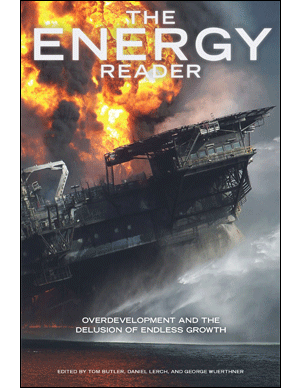
The ENERGY Reader: Overdevelopment and the Delusion of Endless Growth
Bill McKibben Daniel Lerch David Fridley David Hughes Gloria Flora Richard Heinberg
October 31, 2012
What magic, or monster, lurks behind the light switch and the gas pump? Where does the seemingly limitless energy that fuels modern society come from? From oil spills, nuclear accidents, mountaintop removal coal mining, and natural gas “fracking” to large-scale wind, solar, and biomass plants, every source of energy has costs.
Featuring the essays found in ENERGY: Overdevelopment and the Delusion of Endless Growth plus additional material, The ENERGY Reader takes an unflinching look at the systems that support our insatiable thirst for more power along with their unintended side effects. Over thirty leading thinkers on energy, society, and ecology lift the veil on the harsh realities of our pursuit of energy at any price, revealing the true costs, benefits, and limitations of all our energy options.
Edited by Tom Butler, Daniel Lerch and George Wuerthner. Introduction by Richard Heinberg.
Buy
PAPERBACK: via Bookshop.org | Indiebound | Amazon
DIGITAL: via Amazon (Kindle) | Barnes & Noble (Nook) | Kobo (ePub) | eBooks.com (ePub, PDF)
Also available as a large-format book featuring full-color photo spreads.
Read online
Thanks to the generosity of the Foundation for Deep Ecology, every chapter of The ENERGY Reader is available online:
TABLE OF CONTENTS
Part I. A Deeper Look at the Energy Picture
*On the original book website, the material in Part I was grouped under a section titled “The Energy Picture”
Introduction by Richard Heinberg
Part II. The Predicament
Introduction: Energy, Nature, and the Eco-Social Crisis
Five Carbon Pools, Wes Jackson
Faustian Economics: Hell Hath No Limits, Wendell Berry
Life-Affirming Beauty, Sandra B. Lubarsky
Our Global Ponzi Economy, Lester R. Brown
Coal: The Greatest Threat to Civilization, James Hansen
The View from Oil’s Peak, Richard Heinberg
Energy Return on Investment, Charles A. S. Hall
Alternative Energy Challenges, David Fridley
When Risk Assessment Is Risky: Predicting the Effects of Technology, David Ehrenfeld
Malevolent and Malignant Threats, R. James Woolsey
Progress vs. Apocalypse: The Stories We Tell Ourselves, John Michael Greer
Part III. The Landscape of Energy
*On the original book website, the material in Part III was grouped under sections titled “The Energy Terrain” and “Energy in Numbers”
Introduction by David Murphy
Part IV. False Solutions
Introduction: False Solutions to the Energy Challenge
Drill Baby Drill: Why It Won’t Work for Long-Term Energy Sustainability, David Hughes
Nuclear Power and the Earth, Richard Bell
The False Promise of “Clean” Coal, Jeff Goodell
The Whole Fracking Enchilada, Sandra Steingraber
River Killers: The False Solution of Megadams, Juan Pablo Orrego
Bioenergy: A Disaster for Biodiversity, Health, and Human Rights, Rachel Smolker
Oil Shale Development: Looming Threat to Western Wildlands, George Wuerthner
Gas Hydrates: A Dangerously Large Source of Unconventional Hydrocarbons, George Wuerthner
Regulatory Illusion, Brian L. Horesji
Retooling the Planet: The False Promise of Geoengineering, ETC Group
Part V. Under Attack
Introduction: Onslaught of the Energy Machine
Will Drilling Spell the End of a Quintessential American Landscape?, Erik Molvar
Backing the Front: Fighting Oil and Gas Development in Montana’s Rocky Mountain Front, Gloria Flora (The ENERGY Reader only)
Tar Sands, Pipelines, and the Threat to First Nations, Winona LaDuke, with Martin Curry (The ENERGY Reader only)
Sweet and Sour: The Curse of Oil in the Niger Delta, Michael Watts (The ENERGY Reader only)
Outsourcing Pollution and Energy-Intensive Production, Vandana Shiva (The ENERGY Reader only)
Part VI. Depowering Destruction
Introduction: Toward an Energy Economy as if Nature Mattered
The Case for Conservation, Richard Heinberg
Reinventing Fire, Amory B. Lovins
Cap the Grid, Robert E. King
Protected Areas: Foundation of a Better Future Relationship with Energy, Harvey Locke
Three Steps to Establish a Politics of Global Warming, Bill McKibben
Distributed Renewable Generation: Why It Should Be the Centerpiece of U.S. Energy Policy, Sheila Bowers and Bill Powers
No Ecological Sustainability without Limits to Growth, Philip Cafaro
Part VII. What We’re for
Afterword: Places Where the Wind Carries the Ashes of Ancestors, Lisi Krall
Praise for ENERGY and The ENERGY Reader

“A great resource, a wonderful collection.”
— Eric Zencey, Fellow, The Gund Institute for Ecological Economics
“It’s great! Thanks so much.”
— Daniel Blumstein, Chair, Department of Ecology and Evolutionary Biology, Univ. of California, Los Angeles
“A wonderfully written book rich with information and probing perspectives!”
— Daniel Fernandez, Faculty, Science and Environmental Policy, California State University – Monterey Bay
“I found the material excellent.”
— Daniel Leavell, Associate Professor of Geology, The Ohio State University
“Very helpful and informative.”
— Jeffrey Broadbent, Associate Professor, Department of Sociology, University of Minnesota
“Excellent, comprehensive, well laid-out — a great selection of contributors.”
— Mike Snyder, Founder and Filmmaker at Interdependent Pictures and Adjunct Professor at Allegany College of Maryland
CONTRIBUTING WRITERS: Doug Tompkins, Wes Jackson, Wendell Berry, Sandra Lubarsky, Lester Brown, James Hansen, Richard Heinberg, Charles Hall, David Fridley, David Ehrenfeld, James Woolsey, John Michael Greer, David Murphy, David Hughes, Richard Bell, Jeff Goodell, Sandra Steingraber, Juan Pablo Orrego, Rachel Smolker, Brian Horesji, ETC Group, Erik Molvar, Amory Lovins, Robert King, Harvey Locke, Bill McKibben, Philip Cafaro, Sheila Bowers, Bill Powers, Lisi Krall. The ENERGY Reader includes additional chapters by Winona LaDuke, Vandana Shiva, Gloria Flora, and Michael Watts.
Published by the Foundation for Deep Ecology in collaboration with Watershed Media and Post Carbon Institute. 384 pages, 6” x 9”, 7 b/w photographs, 5 line illustrations. ISBN 978-0970950093.
